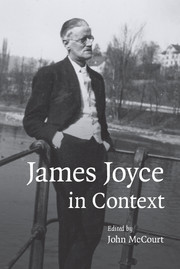Book contents
- Frontmatter
- Contents
- Notes on contributors
- Preface
- List of abbreviations
- PART I LIFE AND WORKS
- PART II THEORY AND CRITICAL RECEPTION
- 4 Genre, place and value: Joyce's reception, 1904–1941
- 5 Post-war Joyce
- 6 Structuralism, deconstruction, post-structuralism
- 7 Gender and sexuality
- 8 Psychoanalysis
- 9 Post-colonialism
- 10 Genetic Joyce criticism
- 11 Translation
- 12 Joyce and world literature
- 13 Twenty-first-century critical contexts
- PART III HISTORICAL AND CULTURAL CONTEXTS
- Further reading
- Index
6 - Structuralism, deconstruction, post-structuralism
Published online by Cambridge University Press: 14 July 2009
- Frontmatter
- Contents
- Notes on contributors
- Preface
- List of abbreviations
- PART I LIFE AND WORKS
- PART II THEORY AND CRITICAL RECEPTION
- 4 Genre, place and value: Joyce's reception, 1904–1941
- 5 Post-war Joyce
- 6 Structuralism, deconstruction, post-structuralism
- 7 Gender and sexuality
- 8 Psychoanalysis
- 9 Post-colonialism
- 10 Genetic Joyce criticism
- 11 Translation
- 12 Joyce and world literature
- 13 Twenty-first-century critical contexts
- PART III HISTORICAL AND CULTURAL CONTEXTS
- Further reading
- Index
Summary
Many of the earliest readers of Ulysses found themselves stymied by Joyce's experiments with form. For example, in a largely positive review, Holbrook Jackson groused that ‘the greatest affront of all is the arrangement of the book, Ulysses is a chaos’. In order to counter such claims, Valéry Larbaud took some effort to emphasise the book's overall structure in his introductory talk at Adrienne Monnier's Maison des Amis des Livres in December 1921 (subsequently published in the first issue of The Criterion). Larbaud stressed that the book was not a chaos and had a structure, and that this structure, registered on the schema Joyce had used while composing it, informed the meanings of the book at the smallest level.
We begin to discover and to anticipate symbols, a design, a plan in what appeared to us at first a brilliant but confused mass of notations, phrases, data, profound thoughts, fantasticalities, splendid images, absurdities, comic or dramatic situations; and we realise that we are before a much more complicated book than we had supposed, that everything which appeared arbitrary and sometimes extravagant is really deliberate and premeditated; in short, that we are before a book which has a key.
The structuring scheme for Ulysses thus explains its welter of images and symbols and so forth and, in so doing, enriches the experience of the text.
- Type
- Chapter
- Information
- James Joyce in Context , pp. 65 - 75Publisher: Cambridge University PressPrint publication year: 2009
- 1
- Cited by



